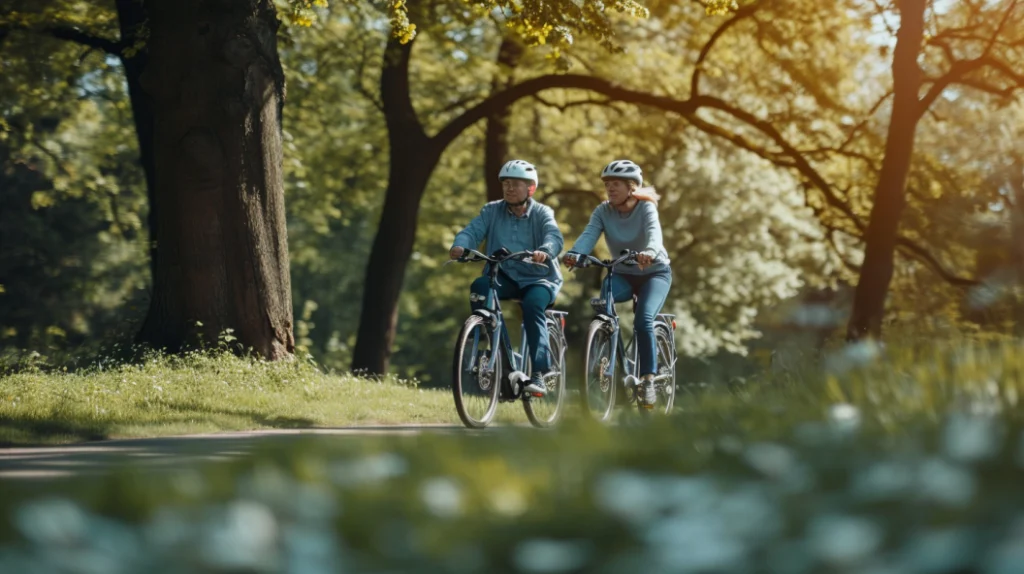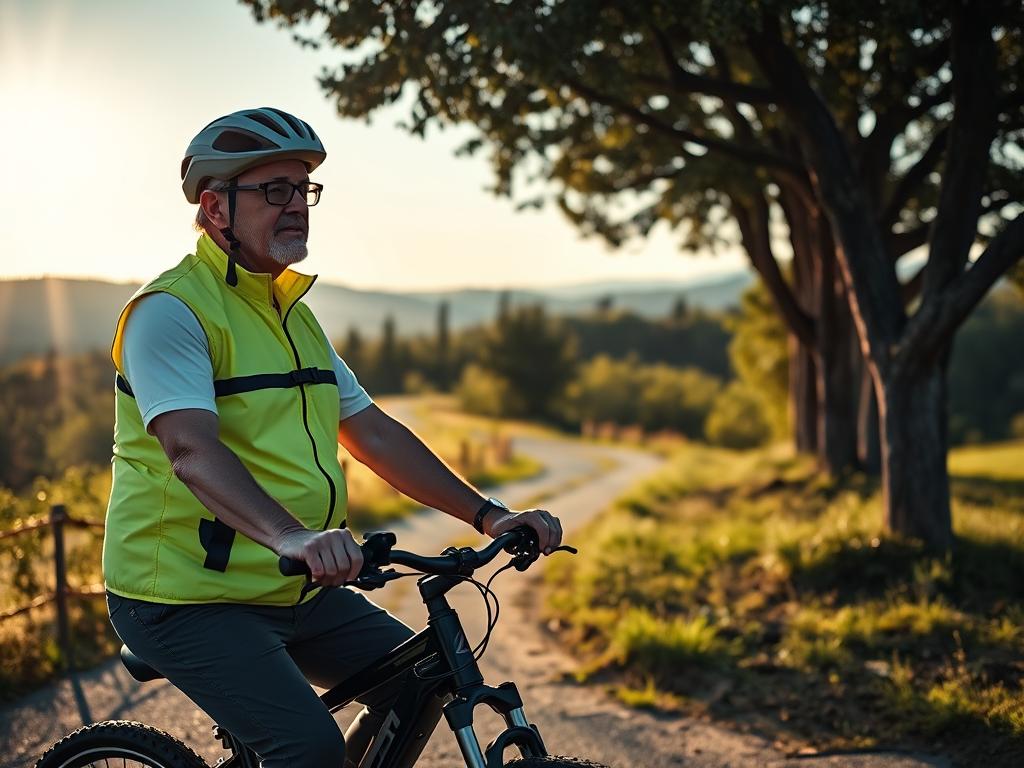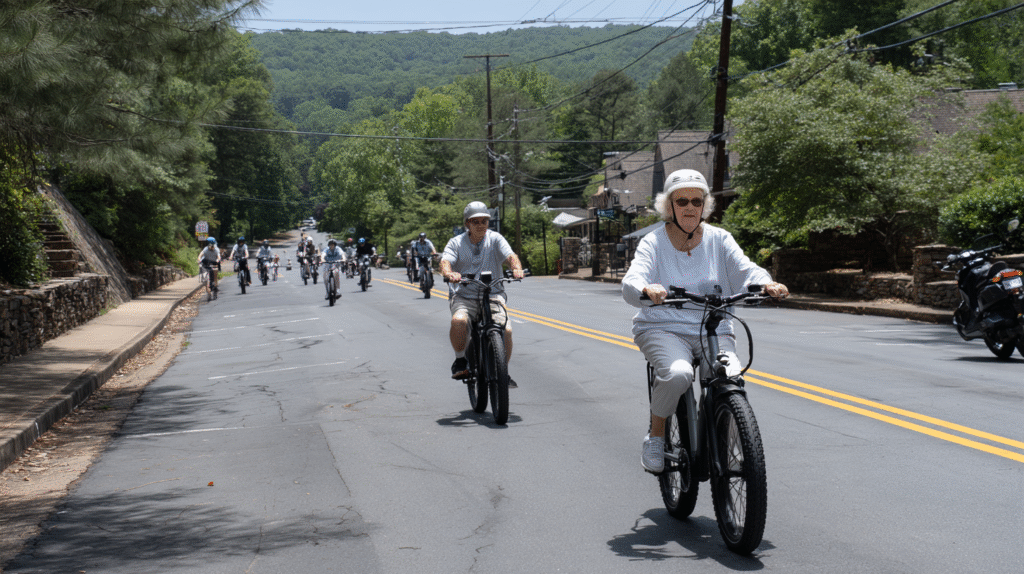Did you know that adults over 55 represent the fastest-growing demographic of electric bike riders? Since 2020, there’s been an 85% increase in adoption. This rise is due to how e-bikes make cycling easier for older adults, combining exercise with assistance. It is esential for Seniors Learning To Ride Your eBike
Age shouldn’t stop you from enjoying the outdoors. Electric bikes for seniors are perfect. They ease joint strain, conquer hills, and extend your ride. Many older adults find a new sense of freedom and independence with e-biking.
We get it. You might worry about balance, falling, or handling an e-bike’s weight and power. These fears are normal but can be beaten with the right help. At EbikesUS.com, we’ve guided many older riders to e-bike mastery safely and confidently.
This guide will teach you how to start and stop smoothly, balance at low speeds, use pedal assist levels, and turn safely. With the right steps, you’ll enjoy the many perks of safe ebike riding.
Table of Contents
Key Takeaways for Seniors Learning To Ride Your eBike
- E-bikes can extend your cycling range by 2-3 times compared to conventional bikes
- Proper training reduces fall risk by up to 75% for new older riders
- Starting with the motor off helps you get comfortable with the bike’s weight and balance
- Always check critical components before each ride for maximum safety
- Senior-friendly features like step-through frames make mounting and dismounting easier
- Consistent practice in safe environments builds confidence and riding skills
Mastering smooth starts and stops with an electric boost for Seniors

E-bikes help seniors a lot, but learning to use the electric boost takes time. It’s important to practice and understand how it works. This helps build confidence and safety on rides.
How does the electric boost engage on most e-bikes?
In the USA, most e-bikes have pedal-assist or throttle control. Pedal-assist turns on the motor when you pedal. Throttle control uses a grip or lever, like a motorcycle.
Quality e-bikes use sensors to help decide when to assist. Cadence sensors check if you’re pedaling. Torque sensors measure how hard you pedal.
Torque sensors are better for seniors. They give power based on how hard you pedal. This makes the ride feel natural.
Understanding the initial torque: Tips for avoiding jerky take-offs for Seniors
The first power surge can be scary for new seniors. It’s important to start smoothly.
Start with the motor off or on the lowest setting. Get comfortable before using more power. This helps you start smoothly.
Use gentle, even pressure on the pedals. Sudden pedaling can make the motor kick in too fast. Aim for smooth strokes.
Practice makes perfect for ebike safety. Try starts and stops in a safe place. Many places offer courses for seniors to learn these skills.
What are best practices for seniors, initiating a smooth start on an incline?
Starting on hills is tricky for seniors. You need to balance gravity and electric help.
Position your bike at a 90-degree angle to the slope. This helps with balance. Shift to a lower gear before climbing.
Choose the right assist level for the hill. Too little makes it hard, too much can cause problems.
Use the “power pedal position” for better leverage. Push down on one pedal while releasing the brakes. This starts you off smoothly.
Learning to start on hills takes time. Be patient. Confidence comes with practice.
Coordinating pedal pressure with motor assistance for seamless acceleration
Smooth riding comes from matching your pedaling with the motor’s help. This makes riding easier for all seniors.
Find your bike’s “power band” where pedaling and motor work best together. This is usually at 60-80 pedaling strokes per minute.
Adjust your pedal pressure based on the terrain and speed you want. Use light pressure for flat areas and more for hills.
For stopping, pedal less and downshift. Use low assist levels as you slow down. This helps with stopping safely, especially in cities.
Every e-bike is different. Get to know how your bike responds. This makes riding smoother.
With practice, you’ll get better at using the motor. This makes e-biking safe and fun for seniors.
How can seniors improve balance and control at low speeds?

Learning to ride an e-bike at slow speeds can be tough for seniors. But, with the right techniques and practice, you can get better. Let’s look at how to improve balance and control at slower speeds.
Why is low-speed maneuvering particularly challenging on e-bikes for seniors?
E-bikes are different from regular bikes, especially at slow speeds. They are heavier because of the motor and battery. This makes them feel unstable at first.
At higher speeds, the bike moves forward, helping it stay steady. But, at slow speeds, you need to balance more. This can be hard for seniors who might not be as steady as they used to be.
The electric motor’s power can also be a challenge. It can surprise riders during slow moves like turning in tight spaces. That’s why seniors need to learn special ebike handling skills for safety.
The importance of correct bike fit for senior e-bike riders’ balance
Finding the right e-bike fit is key for balance and control. Many seniors ride bikes that don’t fit them well, making it harder.
Start with the right frame size. You should be able to stand over the bike with both feet flat and have some room. Saddle height is also important. Your leg should almost be fully extended when the pedal is down.
The handlebar’s position affects your balance and control. For seniors, a higher handlebar helps keep you upright. This reduces back and neck strain and improves visibility.
Getting a professional bike fit at a local shop is a good idea. It’s a small investment that can make a big difference in comfort and safety, especially for new e-bike riders.
Are there specific e-bike features that aid low-speed control for seniors?
Modern e-bikes have features that help seniors control the bike better at slow speeds. Experts at ebikesus.com say these features are great for older adults in the USA.
Step-through frames make it easier to get on and off the bike. They let you stand with both feet on the ground, making it safer.
Walk-assist mode is very helpful for seniors. It gives a little power to help you push the bike, perfect for crowded areas or steep driveways.
Throttle control helps at slow speeds. It lets you add power without pedaling, making it easier to keep moving through tricky spots.
Wider tires (2.0 inches or more) also help with stability. Many e-bikes for seniors come with these, making it easier to balance.

Core strengthening and balance exercises beneficial for senior e-bike riders
Getting stronger off the bike can help you ride better. Simple exercises can boost your senior ebike confidence building journey.
Try standing on one foot while brushing your teeth. Start with short times and get longer as you get better. For more challenge, try it with your eyes closed or on an unstable surface.
Exercises like gentle planks and seated rotations strengthen your core. Even a few minutes a day can improve your bike stability.
Walking heel-to-toe helps improve your balance. Do this every day to get better at knowing where your body is.
Tai chi or gentle yoga can also help. They improve balance and coordination in older adults. Many community centers offer classes for seniors.
Remember, getting better at balance takes time. Keep practicing on and off your e-bike to get more confident and safe at slow speeds.
Effectively using different pedal assist levels in urban settings for seniors
For seniors riding in city settings, knowing how to use your e-bike’s pedal assist is key. Modern electric bicycles for seniors have various levels to help you tackle urban challenges. Learning to use these features right can make your ride better, extend your range, and keep you safe.
What Are the Typical Pedal Assist Levels and How Do They Differ?
Most e-bikes in the USA have 3-5 pedal assist levels. Some high-end models offer even more control. These levels decide how much power the motor gives you based on how hard you pedal.
Level 0 or “Off” means no help, letting you ride like a regular bike. It’s great for flat areas when you want to exercise or your battery is low.
Level 1 gives 25-50% help, offering a gentle boost that saves battery. Many seniors like this level for easy rides on flat ground.
| Assist Level | Power Assistance | Best Used For | Battery Impact | Riding Feel |
|---|---|---|---|---|
| Level 0 (Off) | 0% | Exercise, flat terrain | None | Traditional bicycle |
| Level 1 (Eco) | 25-50% | Flat roads, light exercise | Minimal drain | Subtle assistance |
| Level 2 (Tour) | 50-100% | Gentle inclines, headwinds | Moderate drain | Noticeable boost |
| Level 3 (Sport) | 100-150% | Steeper hills, fatigue | Significant drain | Strong assistance |
| Level 4/5 (Turbo) | 150-300% | Steep hills, heavy loads | Rapid drain | Powerful boost |
According to EBikesUS.com, levels 2-3 are perfect for most seniors. They offer enough power for everyday riding without feeling too hard.
Levels 4-5 give the most help, up to 300% of your pedaling. They use a lot of battery but are great for tough situations.
Matching Assist Levels to Urban Terrain: Flats, Hills and Headwinds
Urban areas have different challenges that need the right assist levels. Senior-friendly ebike instruction teaches you to adjust levels based on the terrain.
For flat areas, use Level 0-1 to save battery. You’ll still get some exercise and ride at a comfortable 10-12 mph.
When facing hills, use a lower gear and more assist before climbing. This helps avoid knee strain and stalling.
Headwinds can be tough for seniors. Increase your assist level to keep a steady pace without getting too tired. Remember, wind resistance grows with speed, so sometimes slowing down is better than fighting strong gusts.
How Can Using Lower Assist Levels Conserve Battery in the City?
Managing your battery is key for longer rides without worrying about running out. Using lower assist levels wisely can extend your e-bike’s range.
Save high assist levels for tough spots only. Many seniors ride in high modes even on flat ground, which cuts down range.
Use momentum in the city. When stopping, reduce assist and slow down gradually instead of using full power.
Urban riding means lots of stops and starts. Lower assist during acceleration uses less battery while still helping. Once you’re moving fast, the motor needs less power to keep you going.
Aging and e-bike accessibility research shows seniors can ride easily on flat ground with little help. This saves battery for when you really need it. It can add 30-50% to your range compared to always using high assist.
When Is It Appropriate to Use the Highest Assist Level in Urban Riding?
While saving battery is important, there are times when you need the most help. Steep hills are a clear case for high assist, especially if you have joint issues or get tired easily.
Carrying heavy items also calls for high assist. Many seniors use their e-bikes for shopping, and the extra power makes carrying goods easier.
If you’re feeling tired or have overdone it, increase assist to get home safely without straining. Extreme weather like strong winds or heat also might need higher assist to keep you comfortable.
Choosing the right ebike for seniors means looking for models with easy controls for adjusting assist levels. Bikes with handlebar displays that show assist level and battery life are best.
Regular ebike maintenance for seniors should check if assist levels work right. Some bikes might have sensor problems that affect assistance, which can be hard for older riders.
With practice, you’ll know which assist level is best for different city situations. This skill lets you ride confidently and enjoyably while also saving battery.
Practicing turning and maneuvering in safe open spaces for seniors
Finding the right place to practice e-bike skills is key for confidence. For elderly e-bike riders, learning to turn in a safe area is vital. It lays the groundwork for safe riding anywhere.
Why a Large Empty Space is Crucial for Initial Practice
Empty parking lots, school grounds on weekends, or quiet parks are perfect for training. These spots let you focus on handling without fear of traffic or people. ebikesus.com says practicing in calm areas builds muscle memory for safe e-biking for seniors.
Understanding Counter-Steering: How it Applies to E-Bikes
Counter-steering is key for balanced turns. It means pushing the handlebar slightly in the opposite direction of your turn. Many e-bike lessons for older adults teach this. It’s crucial for heavier electric bikes. Try it at moderate speeds to see how your bike handles.
Practicing Wide and Tight Turns at Various Speeds
Begin with wide, slow turns. As you get more comfortable, try tighter turns. This helps seniors adapting to e-bikes develop natural turning skills. Practice figure-eight patterns to get better at both left and right turns.
How an E-Bike’s Weight and Motor Affect Cornering
E-bikes are 20-30 pounds heavier than regular bikes, which changes how they turn. But, many e-bikes are stable in turns because of their lower center of gravity. Slow down before turns to build e-bike confidence for the elderly.






